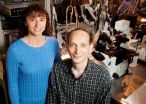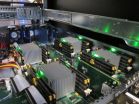(Press-News.org) CHAMPAIGN, Ill. — Using a high-resolution single-molecule study technique, University of Illinois researchers have seen the very subtle differences between two branches of an important family of neurotransmitter-gated ion channels.
Professor Claudio Grosman and research scientist Gisela Cymes published their work in the journal Nature.
Nicotinic-type receptors are proteins embedded in the membranes of nerve and muscle cells that regulate activity. A neurotransmitter, such as acetylcholine, triggers a small conformation change in the protein that opens a channel and allows ions to flow into the cell. These receptors are key players in muscle motion and neurological diseases such as epilepsy.
The protein family is divided into two classes, with very similar structure but different function: One mediates inhibition by channeling anions, or negatively charged ions, while the other mediates excitation by channeling positively charged cations.
"This is the yin and yang of the central nervous system," said Grosman, a professor of molecular and integrative physiology, of biophysics and of neuroscience. "The anion members of the family and the cation members of the family pretty much look the same. The overall structure is the same. So, the question is, what is the reason for the different charge selectivity?"
The team focused on the segment of protein lining the inside of the channel. The two types of channels display very small differences in their sequence of amino acids, the building blocks of proteins. Both the anion-selective and cation-selective channels have a ring of basic amino acids, lysine or arginine, which generally carry a positive charge. This makes sense for an anion-selective channel, but raises some questions about why cations are not repelled by these positive charges.
The charge of amino acid residues is a fundamental aspect of protein function and structure. In order to model proteins computationally, researchers have to assign a charge to each residue, so they rely on the charge the amino acid would display in bulk water – for example, assuming that basic residues are always positively charged. However, proteins offer a much more complex environment, and it can be difficult for researchers to determine whether a particular amino acid has accepted or lost a proton to become charged.
Grosman and Cymes use an approach called patch-clamp recording, a single-molecule technique that allows them to measure binding and unbinding of single protons in functioning molecules, something that other powerful approaches cannot achieve.
With patch-clamp recording, the researchers could see the charge state of working ion channels in living cells. They saw that, in anion-selective channels, the basic residues appear to have the expected positive charge. However, in the cation-selective channels, the lysine or arginine seems to be tucked into the protein structure so that it cannot accept a proton from the surrounding environment and instead remains neutral. This allows cation-selective channels to keep the basic residues in their sequential place without having to substitute them with other amino acids.
"These channels are the subject of a lot of computational studies. Before this paper, if researchers had to model these channels, they would always run the simulation with all the ionizable residues charged, and the simulation could well be wrong," Grosman said. "With small tweaks, changing the position of the amino acid changes its properties. For a lysine to be protonated or deprotonated is a big difference. It's not trivial."
"Overall, we want to emphasize the notion that the properties of these chargeable amino acids depends strongly on their particular microenvironment in the whole protein," Grosman added.
While the study focused on muscle acetylcholine receptors, Grosman believes the "tucked-in" principle holds true for the entire superfamily of nicotinic-type receptors. Next, they plan to use the patch-clamp technique to further investigate the amino acids neighboring the lysine or arginine to gain a greater understanding of how this class of proteins regulates inhibition and excitation.
"This approach has opened a window and we can start understanding things that were intractable until now," said Grosman. "This is important because it brings us closer to what the protein actually looks like if we want to understand how it works."
INFORMATION:
This work was supported by the National Institutes of Health.
Editor's note: To contact Claudio Grosman, call 217-244-1736; email grosman@life.illinois.edu. The paper, "Tunable pKa Values and the Basis of Opposite Charge Selectivities in Nicotinic-Type Receptors," is available online at http://www.nature.com/nature/journal/vaop/ncurrent/full/nature10015.html.
Small change makes a big difference for ion channels
2011-06-03
ELSE PRESS RELEASES FROM THIS DATE:
Phase change memory-based 'moneta'system points to the future of computer storage
2011-06-03
A University of California, San Diego faculty-student team is about to demonstrate a first-of-its kind, phase-change memory solid state storage device that provides performance thousands of times faster than a conventional hard drive and up to seven times faster than current state-of-the-art solid-state drives (SSDs).
The device was developed in the Computer Science and Engineering department at the UC San Diego Jacobs School of Engineering and will be on exhibit June 7-8 at DAC 2011, the world's leading technical conference and trade show on electronic design automation, ...
Northern Rock Launches New Issue of its Easy Access Online Saver
2011-06-03
Northern Rock has announced the launch of the latest issue of its easy access savings account for customers wishing to manage their funds exclusively online. E-Saver (Issue 6) is available now and pays 2.75% gross* pa/AER**.
The new Northern Rock savings account can be opened with an initial investment of GBP1 and E-Saver (Issue 6) allows subsequent deposits from as little as GBP1. The account allows a balance of up to GBP100,000 and account holders can choose to have their interest paid either annually on 11 March or monthly (on 10th of the month. Monthly gross* is ...
Newberry South Carolina Hotel Provides Affordable Lodging to Guests Attending Taste of Newberry
2011-06-03
The Holiday Inn Express & Suites Newberry SC Hotel offers convenient lodging to guests attending Taste of Newberry at Memorial Square in downtown Newberry. The event will take place from 5:00 - 7:30pm on Friday, June 17, 2011. It will include Newberry's finest cuisine from local restaurants, wine tastings and live music.
Selections will features tastes of barbecue, shrimp, beef Wellington, prime rib and sides of fried pickles and pasta salad, and more from many participating restaurants including Steven W's Bistro, Delamaters, The Grille on Main, Ronnie's Restaurant, ...
Eating dirt can be good for the belly, researchers find
2011-06-03
Most of us never considered eating the mud pies we made as kids, but for many people all over the world, dining on dirt is nothing out of the ordinary. Now an extensive meta-analysis forthcoming in the June issue of The Quarterly Review of Biology helps explain why.
According to the research, the most probable explanation for human geophagy—the eating of earth—is that it protects the stomach against toxins, parasites, and pathogens.
The first written account of human geophagy comes from Hippocrates more than 2,000 years ago, says Sera Young, a researcher at Cornell ...
Research reveals effectiveness of seizure treatments for children with autism
2011-06-03
Physicians will have a better guide for more effectively managing treatment of children experiencing seizures related to autism with the results of a study by researchers at Arizona State University and the University of Texas-Houston.
From 25 to 35 percent of people with autism will eventually experience full-scale seizures. Many others will have seizure-like brain activity, in which there is no obvious effect on muscles but potential effects on brain functioning, such as temporary loss of attention.
Little has been known about which traditional treatments for epileptic ...
ASCO: Experimental vaccine made from frozen immune cells shows promise for prostate cancer patients
2011-06-03
Metastatic prostate cancer patients who received an investigational vaccine made from their own frozen immune cells lived 10 months longer than those not treated with it, according to data being presented by researchers from the Kimmel Cancer Center at Jefferson at the 2011 American Society of Clinical Oncology annual meeting in Chicago on Saturday, June 4. (ABSTRACT #4534)
In an exploratory, multi-institutional analysis, researchers administered the vaccine APC8015F to a group of patients from the control arm of three randomized, Phase 3 clinical trials evaluating sipuleucel-T, ...
ASCO: Glioblastoma in the 21st century: Wealthier patients living longer than poorer patients
2011-06-03
Survival rates of wealthier patients and those younger than 70 with glioblastoma, the most common and aggressive malignant brain tumor, have improved since 2000, whereas rates for those living in poorer areas and older than 70 have remained stagnant, according to an abstract being presented at the American Society of Clinical Oncology annual meeting in Chicago by Thomas Jefferson University Hospital researchers on Saturday, June 4. (ABSTRACT #6089).
The addition of concurrent and adjuvant temozolomide, a chemotherapy drug also referred to as TMZ, to post-operative radiation ...
Depression and negative thoughts
2011-06-03
We all have our ups and downs—a fight with a friend, a divorce, the loss of a parent. But most of us get over it. Only some go on to develop major depression. Now, a new study, which will be published in an upcoming issue of Psychological Science, a journal of the Association for Psychological Science, suggests part of the reason may be that people with depression get stuck on bad thoughts because they're unable to turn their attention away.
People who don't recover from negative events seem to keep going over their troubles. "They basically get stuck in a mindset where ...
ASCO: Emerging trends in radiation therapy for women over 70 with early stage breast cancer
2011-06-03
Patterns of radiation usage in breast conserving therapy for women 70 years and older with stage I breast cancer are changing: more women are opting for radioactive implants and those with estrogen positive tumors are opting out of radiation therapy, according to an abstract being presented at the American Society of Clinical Oncology annual meeting in Chicago by Thomas Jefferson University Hospital researchers on Saturday, June 4. The abstract (#6094) received an ASCO Merit Award.
In another abstract (#1037), the researchers report that women with estrogen negative tumors ...
GEN reports on advances in novel protein kinase inhibitor development
2011-06-03
New Rochelle, NY, June 2, 2011—Biotech scientists are working on novel protein kinase inhibitors that are targeting a host of conditions ranging from atherosclerosis to neurodegenerative diseases, reports Genetic Engineering & Biotechnology News (GEN). Recent developments in the protein kinase inhibitor field include innovative paradigms for drug development, improved inhibitor profiling and selectivity strategies, and the expansion of disease targets (e.g., Alzheimer disease and traumatic brain injury), according to the June 1 issue of GEN (http://www.genengnews.com/gen-articles/kinase-inhibitor-obstacles-falling/3674/).
"Protein ...



